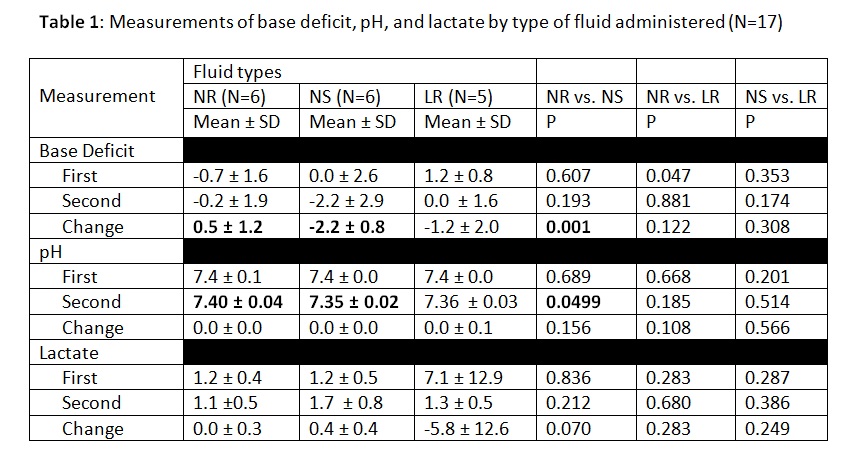OT-123
Impact of intraoperative fluid management on electrolyte and acid-base variables
Walia H, Hakim M, Miller R, Tumin D, Martin D, Tobias J
Nationwide Children's Hospital, Columbus, Ohio, United states
Introduction: During major surgical procedures, intravascular volume can be maintained with the administration of isotonic fluids such as Lactated Ringers (LR), Normal Saline (NS) or Normosol-R® (NR). While these fluids have sodium concentrations that are close to physiologic levels, they contain varying amounts of chloride and different buffers. These differences may impact acid-base status during major surgery. During intraoperative care, acid-base status may be followed as an indirect measure of intravascular resuscitation and tissue perfusion. Inadequate resuscitation may result in a rising lactic acid concentration, which will be reflected as an increasing base excess. However, an increasing base deficit may also occur merely due to the administration of a large volume of normal saline which results in a dilutional acidosis. This dilutional acidosis may not occur when LR or NR are used for intraoperative resuscitation. The primary objective of the current study was to determine differences in base deficit status based on the fluid used for intraoperative status. The secondary objective was to determine differences in serum pH and lactate levels.
Methods: The study was IRB approved. Following informed consent, fluid administration during spinal surgery was randomized to LR, NS or NR. As clinically indicated, arterial blood gas and electrolyte values were obtained using point-of-care monitoring. Base deficit, pH, and lactate levels at each measurement and between measurements were compared across fluid type administered using a two-sample t-test.
Results: To date, the study cohort included 17 patients (10 females and 7 males) with randomization to NS (6), NR (6), or LR (5) (Table 1). The mean age was 13 ± 2 years and weight was 52 ± 11 kg. For the entire study population, BD was 0.1 ± 1.9 at the first measurement and increased to -0.8 ± 2.4 at the second measurement. Eleven of the 17 patients had an increase in BD during the procedure. Eight patients had an increase in BD of ≥ 2, of whom 5 received NS and 3 received LR. Compared to patients receiving NR, patients receiving NS experienced a greater increase in BD between the first and second measurements (NS: -2.2 ± 0.8 vs. NR: 0.5 ± 1.2, p=0.001) and a lower second measurement of pH (NS: 7.35 ± 0.02 vs. NR: 7.40 ± 0.04, p=0.0499). There were no significant differences between patients receiving LR compared to patients receiving either NR or NS.
Discussion: During spinal surgery, fluid resuscitation with Normosol-R® prevents an increase in BD and a decrease in serum pH compared to NS. No difference was noted between LR and NS.
Conclusion: Normosol safe fluid for spinal surgery
References:
1. Awad S, Allison SP, Lobo DN: The history of 0.9% saline. Clin Nutr 2008; 27:179–188.
2. Scheingraber S, Rehm M, Sehmisch C, et al: Rapid saline infusion produces hyperchloremic acidosis in patients undergoing gynecologic
surgery. Anesthesiology 1999; 90:1265–1270
Top












